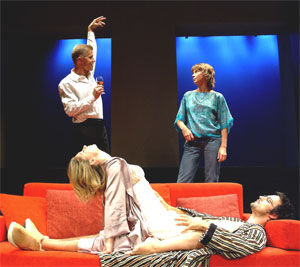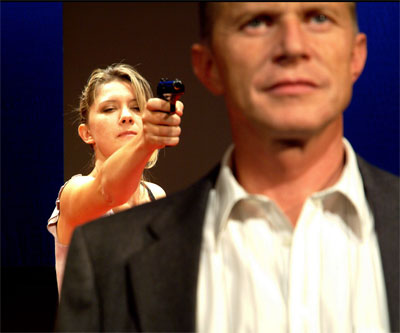

Nora, Nora
A Play by Evald Flisar
For information about performing this play, or purchasing the collected plays, please e-mail texturepress@beyondutopia.com
Synopsis from Collected Plays, I (Texture Press, 2006)
Ibsen's Nora serves the author merely as a starting point for the continued exploration of the state of affairs in the ongoing (and increasingly destructive) battle of the sexes. Today this is a battlefield on which skirmishes are fought between experienced warriors who, instead of swords, use sharpened words. Interwoven throughout this inexorable play of words and people, dictionaries and genders, references and declarations are entire literary and personal worlds that define the context of closeness and alienation among the four characters as an apparently inevitable succession of three dictionaries (peddled by one of them): Dictionary of New Words (infatuation), Dictionary of Cliches (boredom), and Dictionary of Silence (opting out).


Both couples choose the names (Nora and Helmer) themselves – with self-confidence, knowledge and (self) irony, hoping (but not really believing) that "life will not imitate art." It does, and does so repeatedly. Slowly but surely, like a giraffe that has lost its head being transported from one zoo to another (because it couldn't adapt to the height of the entrance), both Nora's and Torvald's (in whatever combination) wind up bereft of a true, committed love safe from corrosive elements. Real relationships are born elsewhere, it seems: on the border of faith, hope and love, on the border that is the most difficult to cross.
Despite it all, a ray of hope emerges at the end of the play with a growing closeness between Nora 1 and Nora 2, and Helmer 1 and Helmer 2, revealed in the understanding and acceptance of similarity and difference (almost compassion ), and in the willingness to see others of the same sex not merely as competitors, but also as fellow victims of the opposite sex. Nora Nora may be seen as an elaboration of the theme explored by the author in his play The Nymph Dies, in which one of the characters, Tristan, says: "There are four people in every marriage: husband and wife, and woman and man that husband and wife would like to be married to."


This is a challenging play for any director, not only because the staging of it requires a physical presentation of two couples living in the same apartment without ever becoming aware of the fact, but also, and perhaps even more so, because of the emotional cruelty the partners display in their attempts to emerge unscathed from repeatedly crumbling relationships.
